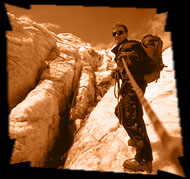
Indoor climbing
 Climbing walls are becoming very popular for beginners and experienced climbers who want to practice various techniques. Although, they do not prepare you for 'cracks', 'bad weather' or other outdoor hazards, they provide some useful conditioning. Indoor walls are now available in most areas of the country. Most provide an area for 'aided climbing' where safety equipment is used. Some have additional areas so you can practise handholds and sideways movements. For your nearest indoor wall see Information: Links.
Climbing walls are becoming very popular for beginners and experienced climbers who want to practice various techniques. Although, they do not prepare you for 'cracks', 'bad weather' or other outdoor hazards, they provide some useful conditioning. Indoor walls are now available in most areas of the country. Most provide an area for 'aided climbing' where safety equipment is used. Some have additional areas so you can practise handholds and sideways movements. For your nearest indoor wall see Information: Links.
Rock climbing
 This was originally a component of mountaineering and in most forms of rock climbing, equipment is used to directly support your weight on a wall. It began as a form of training for Alpine expeditions but now rock climbing is divided into several categories:
This was originally a component of mountaineering and in most forms of rock climbing, equipment is used to directly support your weight on a wall. It began as a form of training for Alpine expeditions but now rock climbing is divided into several categories:
- Outcrop climbing develops basic techniques and use of equipment on climbs of up to 30m/100ft
- Crag climbing is practised on cliffs or crags from 30m - 300m/100 - 1,000ft
- Big wall climbing is the nearest thing to Alpine Climbing without the snow and ice.
- Bouldering is the purest form of rock climbing with no ropes or equipment to aid your climb. It relies on technical ability and is used by some climbers to develop and improve techniques. It is usually practised on smaller outcrops that offer various challenges.

Alpine climbing
 This is restricted to a small percentage of climbers as it involves rock, snow and ice climbing. It is carried out in the larger mountain ranges such as the Alps and requires a great deal of knowledge, experience and expertise. Many expeditions use Alpine climbing techniques.
This is restricted to a small percentage of climbers as it involves rock, snow and ice climbing. It is carried out in the larger mountain ranges such as the Alps and requires a great deal of knowledge, experience and expertise. Many expeditions use Alpine climbing techniques.
Expedition climbing

This is the most expensive form of climbing and commands a professional, full-time commitment. The planning and preparation stages alone can take months. Less than 0.1% of the climbing community are employed as professional, expedition climbers.
Expeditions are undertaken to conquer some of the world largest and most challenging mountains. Each expedition comprises of climbers and a comprehensive support team - although only a selected few will climb to the summit.

Historical Climbs
One of the first climbs to be recorded was in 1786 when two Frenchmen, Balmat and Paccard, successfully climbed Mont Blanc (4814m) for the first time. However, the sport really developed after Wills conquered the Wetterhorn (3,710m) in 1854. Hillary and Tenzing were the first to the summit of Mount Everest (8872m) after many failed and fatal attempts by other climbers.Most of these high altitude climbs used elaborate support systems, including oxygen cylinders. In the Himalayas, Sherpa guides were important expedition members. Since the 1980s Alpine style climbing has become popular for expeditions. This relies more on human ability to adapt to high altitudes.
| Date | Climber/s | Location |
| 1786 | Jacques Balmat/Michel Paccard | Mont Blanc (Italy/France) |
| 1854 | Alfred Wills | Wetterhorn (Switzerland) |
| 1865 | Whymper | Matterhorn (Switzerland) |
| 1897 | Zeebruggen/Vines | Aconcagua (Argentina) |
| 1938 | Heinrich Harrer | Eiger - north face (Switzerland) |
| 1950 | Maurice Herzog/French Expedition | Annapurna - north face (Nepal) |
| 1953 | Hillary/Tenzing | Mount Everest (Nepal/Tibet) |
| 1954 | Italian Expedition | K2 (Tibet/China) |
| 1955 | British Expedition | Kanchenjunga (Nepal/India) |
| 1970 | British Expedition | Annapurna - south face (Nepal) |
| 1981 | Chris Bonnington | Kongur (China) |


